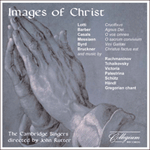Hodie Christus natus est is a double choir (SSAB+ATTB) motet that comes from Palestrina’s third volume of motets published in Venice in 1575. The motet is based on the text of the Magnificat antiphon at Second Vespers on Christmas Day, interspersed with the traditional Christmas cries of ‘noe, noe’. This is a wonderful piece of writing which brilliantly exploits the possibilities of effective contrast: by using the differing sonorities of a high choir and a low choir; by setting off slow-moving passages expressing the solemnity of the celebration of Christ’s birth against rapid antiphonal exchanges of joyful cries of ‘noe, noe’; by using running passages to reflect the singing of the angels and the rejoicing of the archangels and the just; and by reserving until the concluding section of the motet the use of triple time for the final joyful exchanges of ‘noe’.
from notes by Jon Dixon © 2003
Hodie Christus natus est est un motet écrit pour deux chœurs (SSAB+ATTB) qui se trouve dans le troisième volume de motets de Palestrina, publié à Venise en 1575. Il se fonde sur l’antienne du Magnificat aux Secondes Vêpres du jour de Noël pour y mêler les cris traditionnels de Noël, «noe, noe». Il s’agit là d’un morceau à l’écriture merveilleuse qui exploite avec brio les possibilités d’un contraste efficace: en utilisant les différences de sonorités entre le chœur aigu et le chœur grave; en marquant des passages lents exprimant la solennité de la naissance du Christ sur fond d’échanges rapides de cris joyeux, «noe, noe»; par la fluidité des passages décrivant les chants des anges et la joie des archanges et des justes; et en réservant à la conclusion du motet l’utilisation de la mesure à trois temps pour un échange plein d’allégresse de «noe» triomphants.
extrait des notes rédigées par Jon Dixon © 2003
Français: Marie Luccheta
Hodie Christus natus est ist eine doppelchörige Motette (SSAB+ATTB), die aus Palestrinas dritten Motettenbuch stammt, das 1575 in Venedig erschien. Die Motette basiert auf dem Text der Magnifikat-Antiphon der zweiten Vesper des ersten Weihnachtsfeiertags und ist durchsetzt mit den traditionellen weihnachtlichen Rufen „noe, noe“. Es ist dies eine herrliche Komposition, die voller brillanter Kontraste ist: die unterschiedlichen Klangregister des hohen und tiefen Chors; die zunächst langsamen Passagen, Die die feierliche Ehrwürdigkeit der Geburt Christi ausdrücken und gegen die schnellen, antiphonischen, fröhlichen Rufe „noe, noe“ gesetzt sind; die laufenden Passagen, die den Gesang der Engel und den Jubel der Erzengel und der Gerechten repräsentieren und schließlich der Einsatz eines Dreiertakts, von dem erst bei den letzten fröhlichen „noes“ in der abschließenden Passage Gebrauch gemacht wird.
aus dem Begleittext von Jon Dixon © 2003
Deutsch: Viola Scheffel


 Images of Christ
Images of Christ
